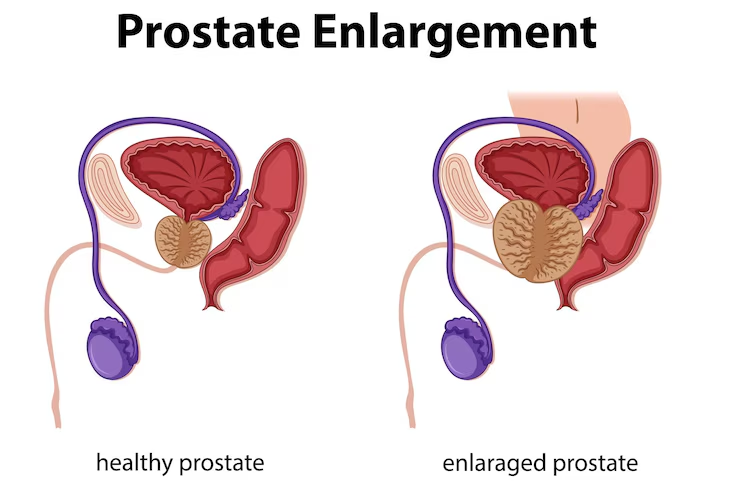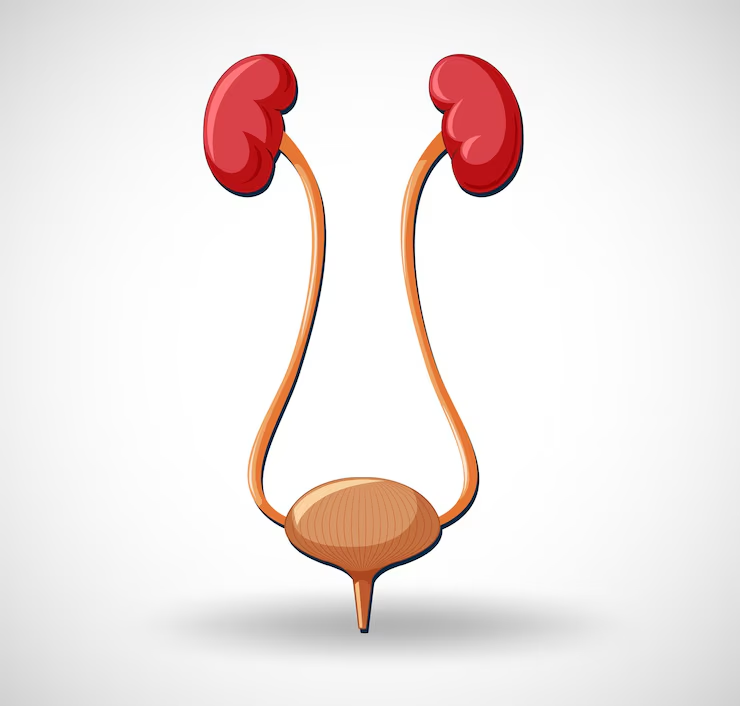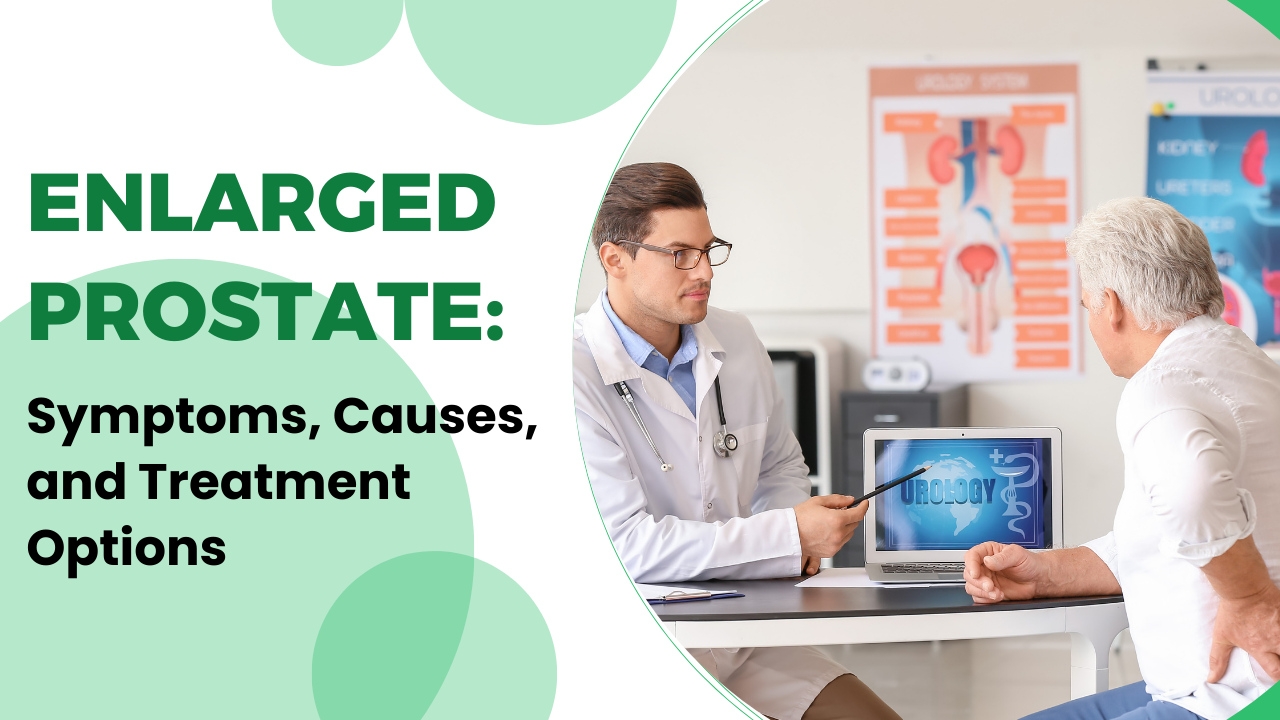The prostate is a small gland found in men, sitting just below the bladder and wrapping around the urethra. It helps make the fluid that mixes with sperm to form semen. As men grow older, the prostate can start to grow in size, which may cause health concerns.
This growth is called benign prostatic hyperplasia, or BPH. It is not cancer, but it can cause discomfort. Some common enlarged prostate symptoms include needing to urinate more often, especially at night, having trouble starting to pee, a slow or weak urine flow, and feeling like the bladder isn’t fully empty.
Knowing the signs of an enlarged prostate early can help men manage the problem before it gets worse. Although it’s a common part of aging, paying attention to these changes can lead to better health and comfort. Regular checkups and healthy habits play an important role in prostate care.
What is an Enlarged Prostate ?

An enlarged prostate, also known as benign prostatic hyperplasia (BPH), is a common condition that affects many men as they age. This condition involves the non-cancerous growth of the prostate gland, which is located just below the bladder and surrounds the urethra. As the prostate grows larger, it begins to press on the urethra, which can disrupt the normal flow of urine.
This pressure can lead to a range of urinary issues that gradually worsen over time. Men with an enlarged prostate may experience symptoms such as difficulty starting urination, a weak or interrupted urine stream, frequent urges to urinate—especially at night—and a feeling that the bladder isn’t completely emptied after urinating.
Although an enlarged prostate is not considered life-threatening, it can have a significant impact on daily comfort and overall quality of life. The symptoms can become increasingly frustrating and may interfere with sleep, work, and social activities if left untreated.
Recognizing the signs of an enlarged prostate early allows for better management and a wider range of treatment options. Lifestyle changes, medications, or medical procedures can help control symptoms and prevent further complications, making timely diagnosis important.
Who is at Risk ?
The chances of experiencing enlarged prostate symptoms go up as men get older. Research has found that this condition becomes more common with age, especially in men over 50. As the prostate continues to grow, it can start to press against the urethra, leading to various urinary issues. These may include frequent urination, trouble starting to urinate, and a weak urine stream. Understanding this age-related risk can help men stay alert to early signs and seek timely care to manage symptoms before they interfere with daily life.
About 50% of men in their 50s experience BPH.
By age 80, up to 90% of men may have some degree of prostate enlargement.
Other risk factors include:
Family history of prostate problems
Obesity
Heart disease and type 2 diabetes
Lack of physical activity
Understanding Enlarged Prostate Symptoms
Common Symptoms
The hallmark enlarged prostate symptoms revolve around urinary difficulties. These include:
Frequent urination – Needing to urinate more often than usual, especially during the night (a condition known as nocturia), which can disturb sleep.

Urgency to urinate – Experiencing a sudden and intense urge to urinate that may feel difficult to control or delay.
Difficulty starting urination – Feeling hesitation or needing to strain in order to begin the flow of urine.
Weak urine stream – Noticing a decrease in the strength or pressure of the urine stream during urination.
Dribbling at the end of urination – Experiencing a slow or prolonged release of urine after finishing, often in the form of drips.
Incomplete bladder emptying – Feeling like the bladder hasn’t fully emptied even after urinating.
Interrupted urine flow – The flow of urine starts, stops, and then starts again several times during one attempt to urinate.
These enlarged prostate symptoms may begin gradually and worsen over time. Although they can vary in severity, any persistent urinary issue should prompt a medical evaluation.
Less Common Symptoms
Pain during urination or ejaculation
Presence of blood in urine (hematuria)
Urinary tract infections (UTIs)
These are less frequent but can indicate more serious complications or the presence of another condition.
Complications of Untreated Enlarged Prostate Symptoms
If left unmanaged, enlarged prostate symptoms can lead to complications such as:
Urinary retention – A sudden and complete inability to pass urine, which may become a medical emergency and often requires the use of a catheter to drain the bladder.
Bladder stones – Hard mineral deposits that can form in the bladder when it doesn’t empty completely, leading to irritation, infection, or difficulty urinating.
Bladder damage – When the bladder becomes overstretched over time due to retained urine, the muscle walls can weaken, reducing the bladder’s ability to contract properly.
Kidney damage – Prolonged urinary retention can increase pressure in the urinary tract, potentially causing harm to the kidneys and affecting their ability to filter waste efficiently.
Early recognition and treatment of enlarged prostate symptoms can help prevent these issues.
Diagnosing Enlarged Prostate Symptoms
A proper diagnosis is essential for effective treatment. Evaluation methods include:
Digital Rectal Exam (DRE) – A hands-on physical examination where a doctor inserts a gloved, lubricated finger into the rectum to feel the size, shape, and texture of the prostate gland.
Prostate-Specific Antigen (PSA) Test – A blood test that measures the level of PSA, a protein produced by the prostate; elevated levels can suggest an enlarged prostate, inflammation, or even prostate cancer.
Urinalysis – A laboratory test of the urine sample to detect signs of infection, blood, or other abnormalities that could explain urinary symptoms.
Postvoid Residual Volume Test – A diagnostic procedure that measures the amount of urine left in the bladder after urination, helping to assess how well the bladder is emptying.

Uroflowmetry – A test that evaluates the speed and strength of urine flow during urination, which can help identify blockages or weak bladder muscles.
Cystoscopy – A procedure in which a thin, flexible tube with a camera (scope) is inserted through the urethra to visually examine the inside of the bladder and prostate area.
Proper diagnosis helps differentiate BPH from other causes of enlarged prostate symptoms, such as prostate cancer or prostatitis.
Natural Treatments for Enlarged Prostate Symptoms
Many men seek natural remedies to reduce enlarged prostate symptoms. Here are some widely used options:
Saw Palmetto
Saw palmetto is a well-known herbal supplement commonly used to address prostate health. It is believed to reduce the size of the prostate and alleviate the symptoms of an enlarged prostate, such as frequent urination and nighttime trips to the bathroom. The primary mechanism behind saw palmetto’s effectiveness is its ability to block the conversion of testosterone into dihydrotestosterone (DHT), a hormone that plays a key role in prostate growth.
Pygeum Africanum
Pygeum is derived from the bark of the African plum tree and is traditionally used to improve urinary health. It is particularly effective in reducing inflammation in the prostate and can help to enhance urinary flow. Studies suggest that pygeum can significantly reduce symptoms such as nocturia (waking up to urinate at night) and other bothersome symptoms of an enlarged prostate, making it a popular choice for those seeking relief.
Beta-Sitosterol
Beta-sitosterol is a plant sterol, a compound found in many herbs, fruits, and vegetables. This natural ingredient has been shown to help improve urine flow and reduce common symptoms of an enlarged prostate, including frequent and urgent need to urinate. It works by reducing inflammation and promoting healthier prostate function, which can ease the discomfort caused by BPH (benign prostatic hyperplasia).
Stinging Nettle Root
Stinging nettle root is often used in combination with other herbs, such as saw palmetto, to treat prostate conditions. This herb has anti-inflammatory properties that help alleviate the symptoms of an enlarged prostate, such as urinary hesitancy (difficulty starting urination) and frequent urination. It works by promoting better urinary flow and reducing discomfort associated with prostate enlargement.
Rye Grass Pollen Extract
Rye grass pollen extract has long been used in Europe to treat prostate-related health issues. It is particularly effective in reducing the volume of residual urine left in the bladder after urination, which can improve overall urinary efficiency. By enhancing the bladder’s ability to fully empty, rye grass pollen extract helps reduce symptoms like urgency and frequent urination associated with an enlarged prostate.
Lifestyle Changes for Managing Enlarged Prostate Symptoms
Natural treatments for enlarged prostate symptoms also involve lifestyle adjustments. Adopting healthy habits such as maintaining a balanced diet, staying hydrated, exercising regularly, reducing stress, and limiting caffeine and alcohol can greatly alleviate discomfort. These changes, combined with herbal remedies, can help manage symptoms and improve overall prostate health.
Dietary Adjustments
Making dietary changes can have a significant impact on managing enlarged prostate symptoms. Eating a low-fat, high-fiber diet can promote prostate health and reduce inflammation. Increasing your intake of omega-3 fatty acids, found in foods like fish and flaxseeds, can also help combat inflammation. Including cruciferous vegetables, such as broccoli, in your meals provides essential nutrients that support prostate health. Additionally, limiting caffeine, alcohol, and spicy foods can help reduce irritation and frequent urination caused by an enlarged prostate.
Regular Exercise
Engaging in regular physical activity is crucial for managing enlarged prostate symptoms. Exercise helps regulate hormone levels, which can aid in reducing prostate size over time. Aerobic exercises, like walking, jogging, or swimming, improve overall health and blood flow. Pelvic floor exercises, also known as Kegels, strengthen the muscles around the bladder and prostate, which can help improve urinary control and reduce symptoms like urgency and frequency.

Bladder Training
Bladder training exercises can be particularly useful for men dealing with enlarged prostate symptoms. These exercises aim to increase bladder capacity and reduce the urgency to urinate. Techniques like scheduling bathroom visits at set intervals and practicing double voiding—urinating, then waiting a few minutes and trying again—can help manage frequent urination and improve bladder control.
Weight Management
Maintaining a healthy weight is essential for managing the symptoms of enlarged prostate. Obesity can exacerbate prostate issues by increasing inflammation and pressure on the bladder. Losing excess weight through a balanced diet and regular exercise can significantly reduce symptoms like frequent urination, urgency, and nocturia, improving overall comfort and quality of life.
Hydration Timing
Proper hydration is important for overall health, but it’s equally important to manage when you drink fluids to control enlarged prostate symptoms. Drinking plenty of water throughout the day helps prevent dehydration, but reducing fluid intake a few hours before bedtime can reduce the likelihood of waking up during the night to urinate (nocturia). This simple adjustment can help you sleep more soundly without frequent interruptions.
Medical Treatments: A Brief Overview
Though this article focuses on natural treatments, it’s helpful to know medical options for enlarged prostate symptoms in severe cases:
Alpha-blockers (e.g., tamsulosin)
Alpha-blockers, such as tamsulosin, are commonly prescribed medications that work by relaxing the muscles around the prostate and bladder. This relaxation helps improve urinary flow and reduces symptoms associated with enlarged prostate, such as frequent urination, difficulty starting urination, and a weak urine stream. These medications can provide quick relief by easing the pressure on the urethra, making it easier to urinate.
5-alpha-reductase inhibitors
5-alpha-reductase inhibitors, such as finasteride, are medications used to shrink the prostate gland over time. These drugs work by blocking the enzyme 5-alpha-reductase, which converts testosterone into dihydrotestosterone (DHT)—a hormone that contributes to prostate growth. By reducing DHT levels, these medications help slow down the enlargement of the prostate, potentially improving urinary symptoms and reducing the need for invasive treatments.
Minimally invasive therapies (e.g., TUMT and TUNA)
For men with enlarged prostate who experience severe symptoms but want to avoid surgery, minimally invasive therapies may be an option. Transurethral Microwave Therapy (TUMT) uses microwave energy to heat and destroy excess prostate tissue, helping to relieve symptoms. Transurethral Needle Ablation (TUNA) employs radiofrequency energy to shrink the prostate tissue. Both treatments offer effective symptom relief with a quicker recovery time compared to traditional surgery.
Surgery (e.g., TURP – Transurethral Resection of the Prostate)
In more severe cases of enlarged prostate, surgical intervention may be necessary. One common procedure is Transurethral Resection of the Prostate (TURP), which involves removing excess prostate tissue to improve urine flow. The procedure is performed through the urethra, meaning no external incisions are needed. TURP is considered the gold standard for treating severe symptoms of BPH, providing significant and long-lasting relief for men whose symptoms do not respond to other treatments.
Preventive Measures for Enlarged Prostate Symptoms
While you cannot completely prevent BPH, certain steps may reduce the likelihood or severity of enlarged prostate symptoms:
Maintain a healthy lifestyle from an early age
Avoid medications that worsen symptoms (like decongestants)
Get regular screenings after age 50
Address urinary issues early with a physician
Myths and Misconceptions
BPH is a Precursor to Cancer
This is a misconception. Benign Prostatic Hyperplasia (BPH) and prostate cancer are two distinct conditions. While they share similar symptoms, such as difficulty urinating, they do not have a direct link. Regular screenings are important to differentiate between the two and ensure early detection of any potential issues.
Only Older Men Have BPH
Although BPH is more common in older men, it can begin as early as the 40s, particularly if there is a genetic predisposition. Men with a family history of prostate issues may experience enlarged prostate symptoms earlier, making early awareness and regular checkups important.
Natural Remedies Are Always Safe
Just because a remedy is natural doesn’t mean it’s always safe. Some herbal supplements can interact with prescription medications or cause side effects. It’s essential to consult with a healthcare professional before using any natural treatments to ensure they are appropriate for your individual health needs.
Conclusion

Enlarged prostate symptoms are a common aspect of aging for men, but they don’t have to diminish quality of life. Early identification of symptoms, combined with lifestyle changes and natural treatments, can significantly alleviate discomfort and prevent complications. Whether you choose herbal remedies, lifestyle interventions, or medical therapies, the goal remains the same: to manage symptoms effectively and maintain a healthy, active life.
If you or a loved one are experiencing any urinary difficulties, don’t hesitate to consult a healthcare provider for proper evaluation and treatment. With the right knowledge and care, enlarged prostate symptoms can be successfully managed at every stage of life.
FAQs
What is an enlarged prostate (BPH) ?
An enlarged prostate, also known as Benign Prostatic Hyperplasia (BPH), is a non-cancerous growth of the prostate gland that can lead to urinary symptoms like frequent urination, difficulty starting urination, and weak urine flow.
What are the common symptoms of an enlarged prostate ?
Common symptoms include frequent urination, especially at night (nocturia), urgency to urinate, difficulty starting urination, a weak urine stream, dribbling at the end of urination, and a feeling that the bladder isn’t fully emptied.
What causes an enlarged prostate ?
The exact cause of BPH is unclear, but it is believed to be related to changes in hormone levels as men age. Increased levels of dihydrotestosterone (DHT) and estrogen may contribute to prostate growth.
How is an enlarged prostate diagnosed ?
Diagnosis typically involves a physical examination, a Digital Rectal Exam (DRE), blood tests to check prostate-specific antigen (PSA) levels, urinalysis, and sometimes imaging or more specialized tests like uroflowmetry or cystoscopy.
What are the treatment options for an enlarged prostate ?
Treatment options include lifestyle changes, medications such as alpha-blockers or 5-alpha-reductase inhibitors, minimally invasive therapies like TUMT or TUNA, and, in severe cases, surgery such as Transurethral Resection of the Prostate (TURP).


